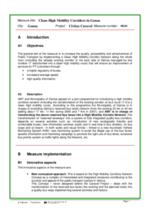Clean high-quality bus corridors
Thematic areas
Demand & urban space management
Summary
In order to improve the quality, accessibility and attractiveness of public transportation in Genoa, the municipality and the public transport operator AMT introduced a network of clean, high-mobility corridors throughout the city.
Implementing sustainable mobility
People are attracted to public transport services by greater bus reliability, increased average speeds and high-quality information. This measure was therefore aimed at transforming the previously existing public transport service into a network of fully integrated high-quality bus corridors, with bus prioritisation lanes and improved information, access and road management.
Specifically, the measure aimed to provide:
- real-time information at bus stops with new and improved “smart stops” (showing arrival time of next bus and service information such as route changes);
- upgraded information in bus shelters, including maps of the immediate area, route maps, intermodality options and points of interest;
- next-stop information and general service information on board buses in both audio and visual formats;
- better integration with the traffic control system allowing bus priority at all intersections controlled by traffic lights;
- monitoring and better control of reserved bus lanes using cameras or other electronic systems to ensure that bus priority lanes are respected;
- fleet renewal programmes based on energy-efficient vehicles;
- bus stops designed to improve access for all, including people with special needs and the elderly; and
- improved road management.
Progress
- 5 km of new mobility corridor were created.
- Information display panels were installed at bus stops and the main intermodal transport nodes, providing information on timetables, connections, tourist attractions etc.
- Real-time passenger information was installed at over 100 stops.
- Bus-stop access was improved, and two bus stops were converted to ensure access to people with reduced mobility.
- Clean buses with Euro IV engines were introduced in the new corridors.
- Automatic vehicle monitoring systems were upgraded in 131 vehicles.
Outcomes
- Bus frequency and punctuality improved.
- Travel times were lowered.
- Emissions were reduced.
- Cost savings were made, allowing for reinvestment in service improvements.
This fact sheet has been updated by a third party on the basis of available information (not by the city itself), therefore we do not guarantee any data with respect to their content, completeness or up-to-dateness.








